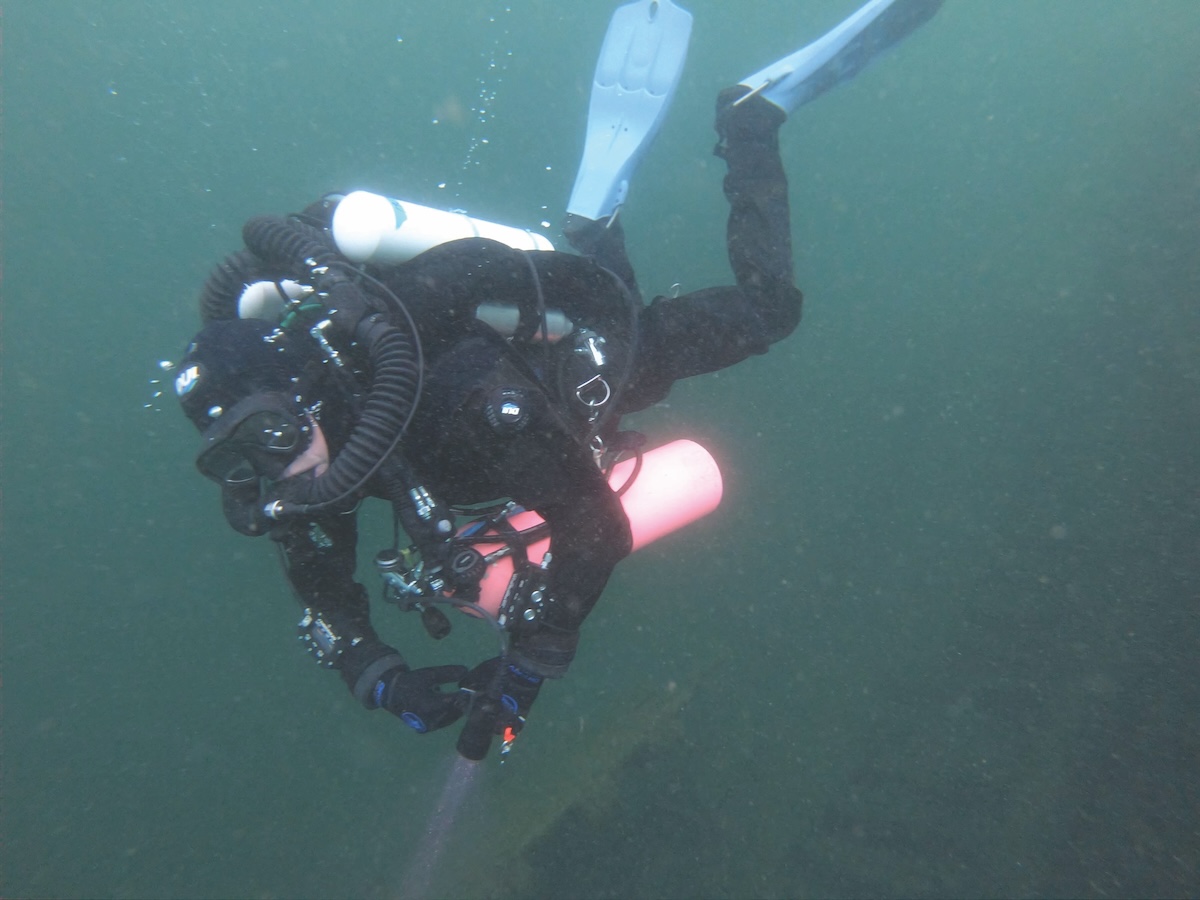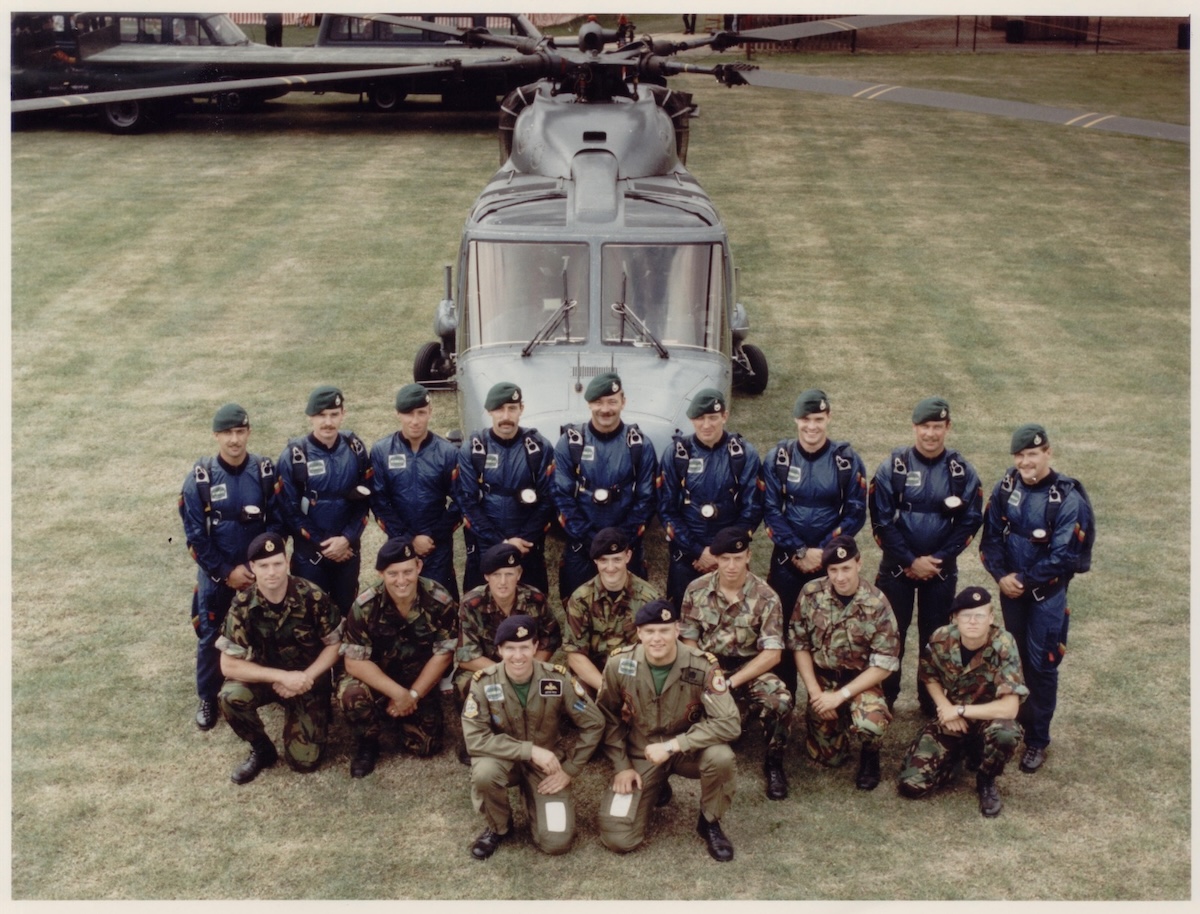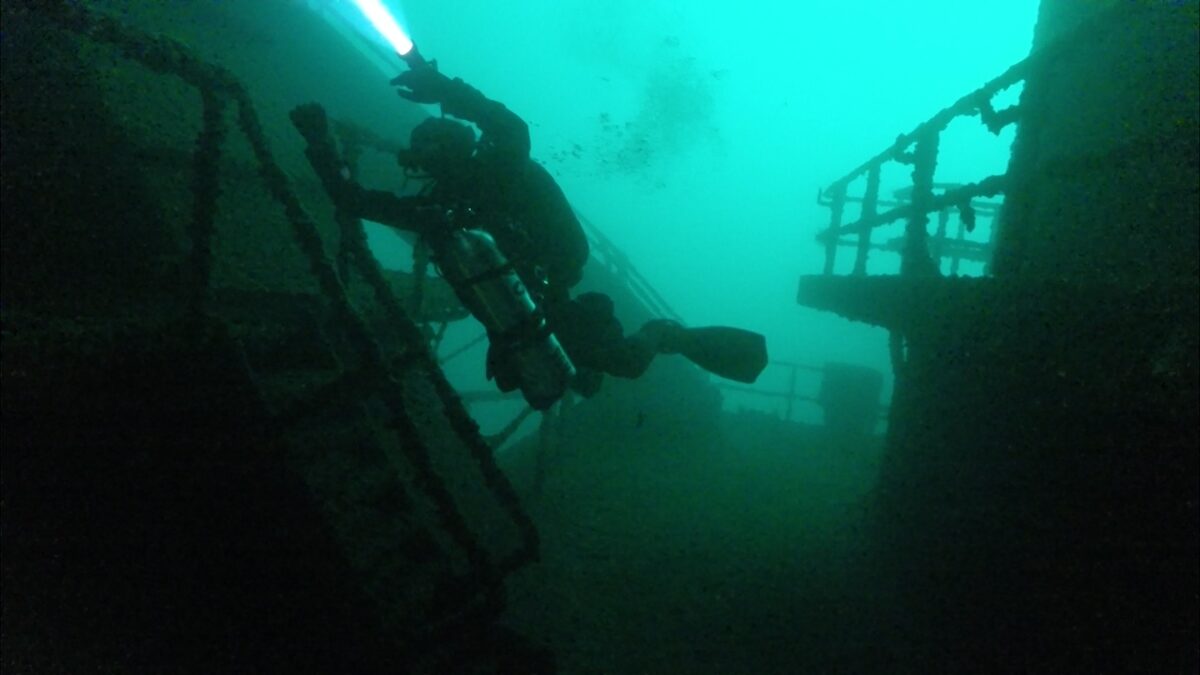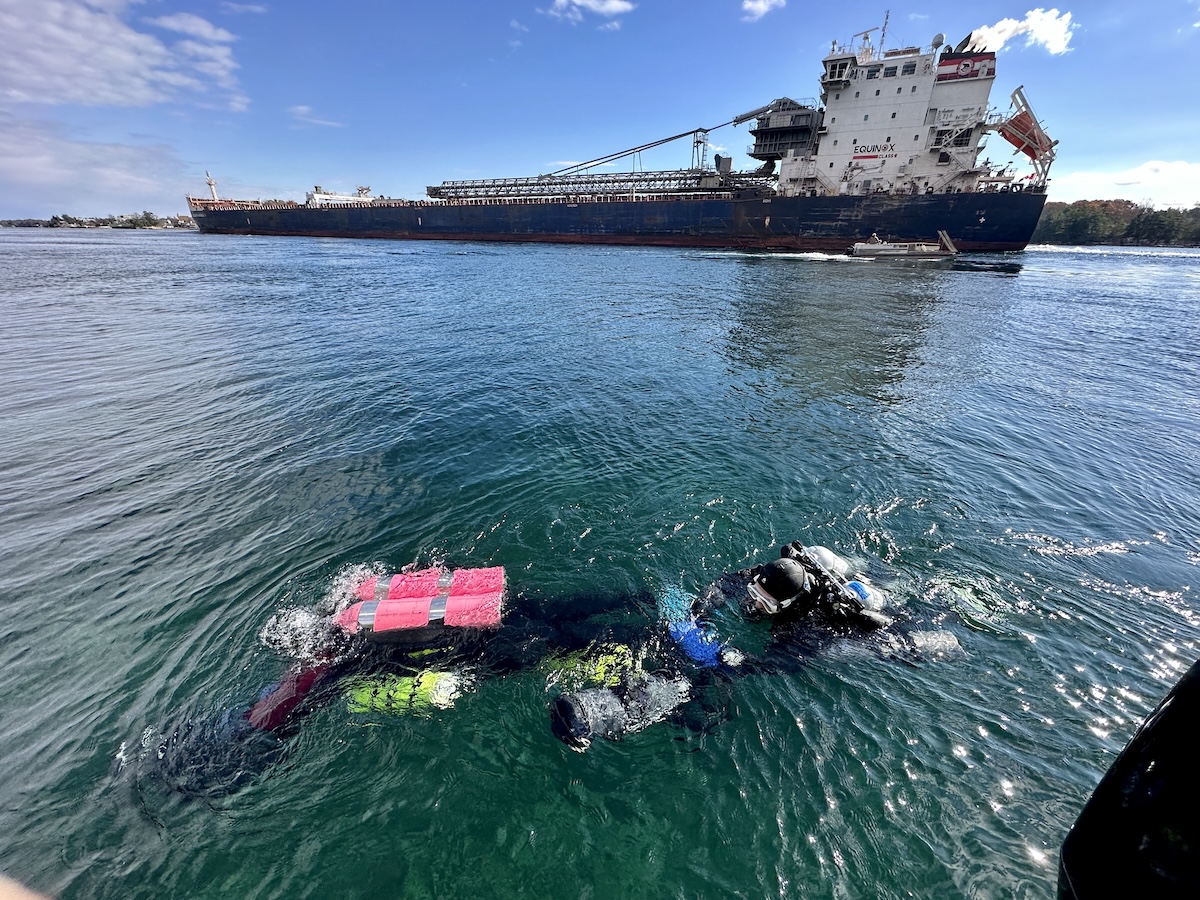
For Andrew Driver, a childhood love of scuba diving has evolved into a lifelong career teaching others the thrill of diving.
As the dive boat motors slowly into the shallows, its crew throws an anchor off the stern and then walks a line ashore to tie off to a rock or a tree. The sheltered bay is almost flat calm, its surface reflecting the vivid blues and greens of a northern summer day.
The passengers are eager to begin their dive. August water temperatures in the St. Lawrence River hover in the balmy mid-70s, and recent good weather means the visibility should be decent.
Standing in just 3 to 4 feet of water, the divers prep their gear, test their masks for leaks, sort out any lingering issues and, most importantly, relax. When it’s time to descend, they’re ready. This is going to be fun.
Their captain and dive master is happy, too. He is looking forward to showing them the unforgettable treasures in the river he loves.
His name is Andrew Driver, and his journey to the Thousand Islands has been a remarkable one, filled with adventures both above and below the waves.
Guerrilla diving
Driver spent the first 16 years of his life in Saltdean, a summer seaside town just a few miles east of Brighton on England’s south coast. Like so many children in the late 1960s and early to mid-’70s, he was enthralled with “The Undersea World of Jacques Cousteau” and couldn’t wait to learn to scuba dive.
“I learned to dive at 12 years old,” Driver recalls. “My dad bought me a kit wetsuit; you had to glue the seams together and put tape on them.”
Nowhere in England is more than 70 miles from the ocean, and “aqua clubs” dotted the country. Driver joined one, and he steadily gained experience through pool dives and occasional field trips.
“It was real guerrilla diving, which was both good and bad,” Diver says with a laugh. “Even if there were rough conditions and bad visibility, we still went out in the instructors’ rigid-hull inflatables. It was a different time.”
One excursion involved visiting Scapa Flow in the Orkney Islands, a few miles north of Scotland’s northernmost tip. A World War I German battle fleet was scuttled here in June 1919; 52 of 74 ships went to the bottom.
“I knew this is what I always wanted to do,” Driver says.

Andrew Driver searching for the remains of a gunner on a B24 bomber who was killed during WWII

Royal Marine Commando’s Free Fall Parachute team in 1990
A commando’s life
Drawn to a life of adventure, Driver made the decision to join the Royal Marines Commandos as a young man. The commandos are one of the Royal Navy’s five fighting arms, specializing in amphibious special operations.
“The military can offer opportunities to do almost anything,” he explains. “You can parachute, fly, sail — really test your mettle and step outside your comfort zone.”
Driver made the most of those opportunities during his eight years as a Royal Marines Commandos officer. He was part of the British National Parachute Team, and he logged a world record- breaking 1,000 parachute jumps with the Royal Marines Free Fall Team.
He received extensive training in Arctic survival, and he became a UK-licensed master of motor and sailing vessels up to 200 gross tons. He also engaged in combat swimming, learning to use oxygen rebreathers.
That’s when his childhood love of scuba diving quickly evolved into a passion for technical diving.
Tech diving exceeds scuba’s recreational limits. It includes deep diving, mixed-gas diving, wreck diving, cave diving, ice diving and more.
“It’s an extreme sport,” Driver explains, comparing deep wreck dives to single-handed ocean sailing. “I love the challenge of it. It’s about the majesty of nature, adventure and risk management.”
Technical diving developed as a distinct discipline from the mid-1980s to mid-1990s. Driver immersed himself in it, becoming an expert in mixed gases and rebreathers.
Three mixtures of oxygen, nitrogen and helium allow divers to go deeper and stay at depth longer: Nitrox, heliox and trimix. A rebreather allows you to breathe the same air over and over, which means longer bottom time, reduced noise and no bubbles.
Today, Driver has more than 25 years experience with technical closed circuit rebreathers, and he is certified to train rebreather diving instructors.
Adventures in boating
Diving wasn’t the only passion Driver’s Royal Marines Commandos experience ignited. He discovered he loved adventures on top of the water as well.
“I served for a year on the HMS London,” Driver explains. “I was part of a marine detachment onboard.”
During one NATO exercise, the warship
endured steady Force 10 conditions on the Beaufort scale, with wind gusts to Force 12. That meant sustained winds of 55-63 mph, with gusts greater than 73 mph, and seas of 29-41 feet.
In such conditions, the gale whips the crests off mountainous waves, and long lines of spindrift makes the sea itself look white. To stand on the ship’s bridge in such a storm was, Driver says, pure magic.
He also served aboard a 55-foot Nicholson military yacht, which carried him to the Canary Islands and on to the Caribbean. Driver was eager to see more; although he took a job as an instructor aboard a live-aboard dive boat following his military service, he soon seized a new opportunity.
“I met someone who needed to have a 26-foot Cheoy Lee sailboat delivered from Mexico to the United States,” he remembers. “It was a woman and her boyfriend, but he ended up in jail down there. Then I went to move the yacht with a guy whose fiance was ill, and she died. So I moved the boat back to the States. It was a terrible mess.”

Blue Foot Diving Charter
The road to the Thousand Islands
In the mid-1990s, Driver was ready to embark on a new adventure: An expedition company in New York City that offered customers opportunities to deep dive, cave dive and even dive with great white sharks. Expeditions ranged from the Amazon to the Arctic, but when the dive outings were local, coastal New York proved to be a challenging location.
“We would load gear and leave at 3 a.m., unload gear, and then have a two-hour boat ride to the dive site,” he explains. “The weather was a real barrier.”
Driver had been taking students to the Thousand Islands since 1999. In 2007, he decided to drop the anchor permanently; today, he makes his home in Clayton, New York, with wife Rebecca Hopfinger, executive director of the Antique Boat Museum.
“For me, the St. Lawrence River is what it’s all about,” he says. “It’s 600 miles from Cape Vincent to the Gulf of St. Lawrence, which makes it the largest navigable inland waterway in the world. It’s narrow, it’s deep, and you never get blown out.
The Thousand Islands are appropriately named, with 1,864 islands scattered across a 50-mile stretch of river. More than 200 shipwrecks, some dating to the War of 1812, rest on the riverbed.
Some are accessible to new divers while others will provide welcome challenges for tech divers. In short, this was the perfect place for Driver to open the doors to a dive charter operation with business partner Greg Mooney.
Adventures in business
Located at the marina at Keewaydin State Park in Alexandria Bay, New York, Blue Foot Divers operates a 32-foot Parker that accommodates six divers and a 27-foot Olympia with a four-diver capacity. The company frequently partners with All About Scuba, a company also based in Alexandria Bay.
Local dive sites, many of them shore dives, are within a 30-minute boat ride. One, the 650-foot Roy A. Jodrey, is less than five minutes away in 250 feet of water.
“It’s the best trimix training wreck,” Driver notes.
Blue Foot Divers also offer charter trips around the United States and around the world. These include diving with humpback whales in the Caribbean, diving with tiger sharks in the Bahamas, deep wreck diving and cave diving in Florida, and megalodon tooth hunting in the Carolinas.
“It was an opportunity to offer these services locally,” Driver says of his business. “Here, it’s primarily wreck diving, but we do some drift dives. That’s fun for people.”
Andrew with the Papua New Guinea local island chief
In a drift dive, divers descend to their preferred depth and allow the current to carry them along to their exit point. And they might discover that wrecks aren’t the only highlights in the river.
At one dive site, divers can see a 46-foot, hand-hewn, white-oak beam that is 200 years old. Lumber baron Andrew Cornwall purchased this land from the government after the Revolutionary War, chopped the forests down, and floated massive “villages” of logs and lumber workers downriver Montreal.
Divers also might spot bottles and other items lost overboard through the years. Certain times of the year are more accommodating for this than others.
“We can have 100-foot visibility here in October and November,” Driver says. “December and January are good too, but that’s hardcore drysuit diving.
“Summer is usually 20 to 30 feet, although that might drop to 15 or 20 feet with plankton, grass, boat traffic and rain,” he continues. “People who completed their open-water certification in the Bahamas will find this to be more challenging.”

For the adventure of it all
In addition to operating dive charters, Driver also drives tour boats for Alexandria Bay-based Uncle Sam Boat Tours during the too-short summer season. Accommodating 300-400 passengers, the boat tours share the remarkable history of the Thousand Islands.
As Driver observes, this region’s appeal is not limited to diving.
“I was 13 years in New York City, but I’m not a city boy,” he says. “It’s quiet and stunningly beautiful here.
“It’s also fascinating,” he adds. “Most people don’t know anything about the river’s commercial and strategic importance to the United States. You also have all the Gilded Age homes along the river.
In the offseason, Driver travels extensively, pursuing a variety of interests. One involves the portable, high-pressure hyperbaric chambers that treat decompression illness.
An International Board of Undersea Medicine chamber instructor, Driver educates divers on hyperbaric oxygen therapy. Given the enduring popularity of live-aboard dive vessels, he focuses on teaching yacht
crews from Florida to Tahiti how to use the chambers to help divers in distress.
In addition, as a professional diver, he has worked on the Discovery Channel’s “Shark Week,” as well as on productions for the History Channel and National Geographic. A recent project involved working with the U.S. Department of Defense’s POW/MIA Accounting Agency to recover the remains of World War II servicemen in Papua New Guinea and Palau.
“We were recovering them from downed aircraft,” he says. “Forensic archaeologists were part of it, because there were high legal standards to prove who they were — documentation, DNA. We were successful.”
While Driver acknowledges that the nature of his work is a bit feast-or-famine, he says that doesn’t faze him. He is dedicated to sharing what he has learned and igniting the same passions in others that have kept him going all these years.
“I am not motivated by money,” he says. “I work for myself, for the adventure of it all.”
To learn more, visit BLUEFOOTDIVING.COM, ALLABOUTSCUBA.COM, USBOATTOURS.COM and VISITTHOUSANDISLANDS.COM.



